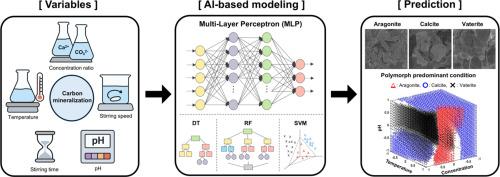Artificial Intelligence Prediction of Carbonate Crystallinity of Carbon Mineralization
引用次数: 0
Abstract
The importance of carbon capture, utilization, and storage (CCUS) for achieving carbon neutrality is increasingly recognized. Carbonate minerals are currently being manufactured from the abundant calcium-containing wastes and minerals that are generated by carbon mineralization technology in industry. Among these, calcium carbonate, which is highly versatile, generally exists in three crystal forms (vaterite, aragonite, and calcite). These three crystal forms must be freely controllable to increase the value and range of use of calcium carbonate. In this study, the variables of concentration, temperature, pH, stirring speed, and stirring time were changed during the reaction of calcium raw material (i.e., CaCl2) and carbon raw material (i.e., K2CO3). In addition, the phase composition ratios were determined by Rietveld refinement analysis using X-ray diffraction (XRD) patterns. Drawing on an extensive set of experimental data, we constructed data-driven predictive models by training and evaluating multilayer perceptron (MLP), support vector machine (SVM), random forest (RF), and decision tree (DT) algorithms. The best-performing model, selected by k-fold cross-validation, was then applied to determine the optimal operating conditions to control crystallinity. This study provides comprehensive knowledge about a system that allows industries to select, manufacture, and produce calcium carbonate in the crystal form they need. It is anticipated that using carbon mineralization technology, which is part of CCUS technology, will contribute to carbon neutrality, while alleviating waste environmental treatment costs.

碳矿化碳酸盐结晶度的人工智能预测
碳捕获、利用和封存(CCUS)对实现碳中和的重要性日益得到认识。碳酸盐矿物是目前工业上利用碳矿化技术产生的大量含钙废物和矿物制造的。其中,用途广泛的碳酸钙,一般以三种晶体形式存在(水晶石、文石和方解石)。这三种晶型必须是自由可控的,以增加碳酸钙的价值和使用范围。在本研究中,改变了钙原料(即CaCl2)和碳原料(即K2CO3)在反应过程中的浓度、温度、pH、搅拌速度和搅拌时间等变量。此外,采用x射线衍射(XRD)图,通过Rietveld细化分析确定了相组成比。利用大量的实验数据,我们通过训练和评估多层感知器(MLP)、支持向量机(SVM)、随机森林(RF)和决策树(DT)算法,构建了数据驱动的预测模型。然后通过k-fold交叉验证选择最佳模型,以确定控制结晶度的最佳操作条件。这项研究提供了一个系统的全面知识,允许工业选择,制造和生产碳酸钙的晶体形式,他们需要。预计使用碳矿化技术(CCUS技术的一部分)将有助于碳中和,同时降低废物环境处理成本。
本文章由计算机程序翻译,如有差异,请以英文原文为准。
求助全文
约1分钟内获得全文
求助全文

 求助内容:
求助内容: 应助结果提醒方式:
应助结果提醒方式:


